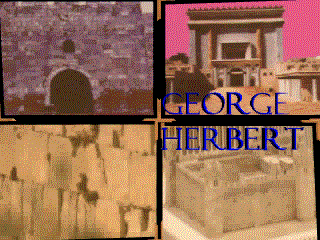![[The Court of the Temple, Jerusalem, Model]](Temcrt.jpg) from
The Temple (1633), by George Herbert:
from
The Temple (1633), by George Herbert:
![[The Court of the Temple, Jerusalem, Model]](Temcrt.jpg) from
The Temple (1633), by George Herbert:
from
The Temple (1633), by George Herbert:
¶ Divinitie
AS men, for fear the starres should sleep and nod,
And trip at night, have spheres suppli'd;
As if a starre were duller then a clod,
Which knows his way without a guide:
Just so the other heav'n they also serve,
Divinities transcendent skie:
Which with the edge of wit they cut and carve.
Reason triumphs, and faith lies by.
Could not that Wisdome, which first broacht the wine,
Have thicken'd it with definitions?
And jagg'd his seamlesse coat, had that been fine,
With curious questions and divisions?
But all the doctrine, which he taught and gave,
Was cleare as heav'n, from whence it came.
At least those beams of truth, which onely save,
Surpasse in brightnesse any flame.
Love God, and love your neighbour. Watch and pray.
Do as ye would be done unto.
O dark instructions; ev'n as dark as day!
Who can these Gordian knots undo?
But he doth bid us take his bloud for wine.
Bid what he please; yet I am sure,
To take and taste what he doth there designe,
Is all that saves, and not obscure.
Then burn thy Epicycles, foolish man;
Break all thy spheres, and save thy head.
Faith needs no staffe of flesh, but stoutly can
To heav'n alone both go, and leade.
|
General Note: When trying to explain the irregular motions of the planets (the wandering stars), astronomers devised ingenious explanations. Herbert parallels this elaborate astonomical explanation to the religious theology of his time. When it was believed that the sun and planets revolved around the earth, the theory explained that they revolved around the earth in perfect spheres. This satisfied the moon and the sun well enough because their movement was regular and in one direction in a straight line (from our point of view). The planets, however, did not move in a straight line but seemed to stop and even go backwards on their path. The theory of perfect spheres was in doubt until someone developed the sphere-in-a-sphere (or circle in a circle) addendum.
In the graphic, a planet is seen in its circle/sphere from above as it moves in a larger circle/sphere around its center, earth. Along the bottom the planet appears as it would be seen from earth. The backward movement is clear. This is what the Theory of Epicycles explained. It explained it well, but the truth is simpler. This is Herbert's point. Related Criticism: "Herbert and the Real Presence" (the number and nature of the sacraments) by R. V. Young. [Poems cited: "Priesthood," "Divinitie," "The Agonie," and "Love (III)"] Personal note: After all the earth-centered universe is ego-centric. |
 JavaScript Version
JavaScript Version
| 1633 Poem Index | Links to Criticism | George Herbert & The Temple Home Page |